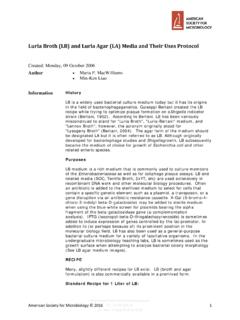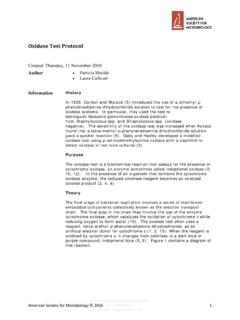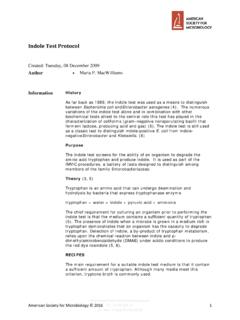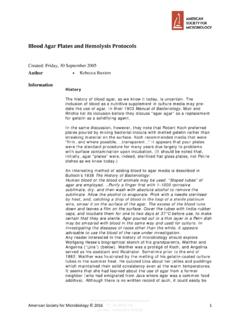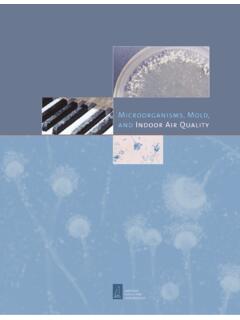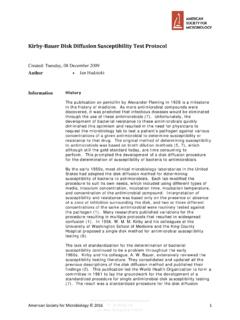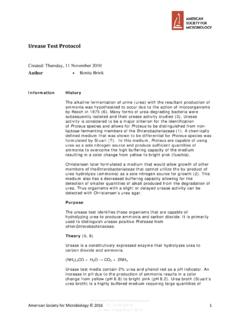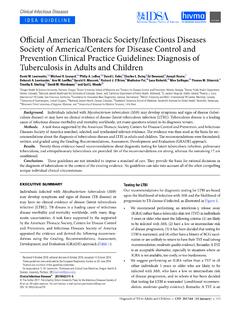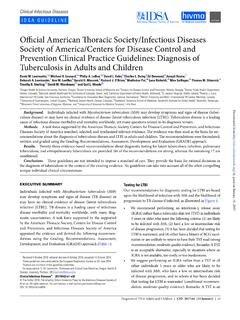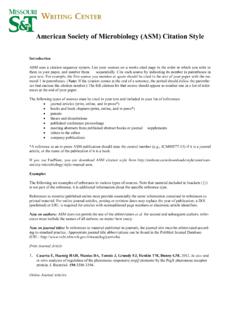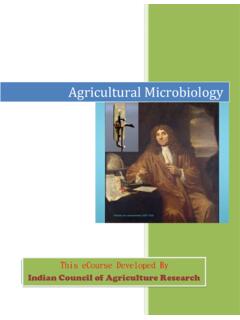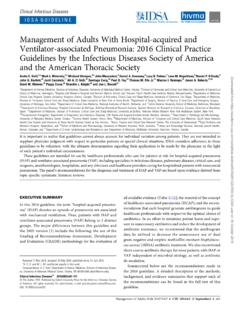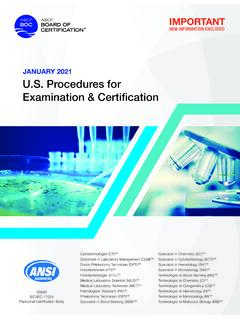Transcription of Gram Stain Protocols - American Society for Microbiology
1 Downloaded from byIP: : Mon, 12 Aug 2019 17:45:19 American Society for Microbiology 2016 1 gram Stain Protocols | | Created: Friday, 30 September 2005 Author Ann C. Smith Marise A. Hussey Information History The gram Stain was first used in 1884 by Hans Christian gram ( gram ,1884). gram was searching for a method that would allow visualization of cocci in tissue sections of lungs of those who had died of pneumonia. Already available was a staining method designed by Robert Koch for visualizing turbercle bacilli.
2 gram devised his method that used Crystal Violet (Gentian Violet) as the primary Stain , an iodine solution as a mordant followed by treatment with ethanol as a decolorizer. This staining procedure left the nuclei of eukaryotic cells in tissue samples unstained while the cocci found in the lungs of those who had succumbed to pneumonia were stained blue/violet. gram found that his Stain worked for visualizing a series of bacteria associated with disease such as the cocci of suppurative arthritis following scarlet fever.
3 He found however that Typhoid bacilli were easily decolorized after the treatment with crystal violet and iodine, when ethanol was added. We now know that those organisms that stained blue/violet with gram s Stain are gram -positive bacteria and include Streptococcus pneumoniae (found in the lungs of those with pneumonia) and Streptococcus pyogenes (from patients with Scarlet fever) while those that were decolorized are gram -negativebacteria such as the Salmonella Typhi that is associated with Typhoid fever.
4 You may read the original publication of the staining procedure in the translated article "The Differential Staining of Schizomycetes in tissue sections and in dried preparations". Purpose The gram Stain is fundamental to the phenotypic characterization of bacteria. The staining procedure differentiates organisms of the domain Bacteria according to cell wall structure. gram -positive cells have a thick peptidoglycan layer and Stain blue to purple. gram -negative cells have a thin peptidoglycan layer and Stain red to pink.
5 Theory The gram Stain , the most widely used staining procedure in bacteriology, is a complex and differential staining procedure. Through a series of staining and decolorization steps, organisms in the Domain Bacteria are differentiated according to cell wall composition. gram -positive bacteria Downloaded from byIP: : Mon, 12 Aug 2019 17:45:19 American Society for Microbiology 2016 2 have cell walls that contain thick layers of peptidoglycan (90% of cell wall). These Stain purple. gram -negative bacteria have walls with thin layers of peptidoglycan (10% of wall), and high lipid content.
6 These Stain pink. This staining procedure is not used for Archeae or Eukaryotes as both lack peptidoglycan. The performance of the gram Stain on any sample requires four basic steps that include applying a primary Stain (crystal violet) to a heat-fixed smear, followed by the addition of a mordant ( gram s Iodine), rapid decolorization with alcohol, acetone, or a mixture of alcohol and acetone and lastly, counterstaining with safranin. Details of the chemical mechanism of the gram Stain were determined in 1983 (Davies et al.)
7 ,1983 and Beveridge and Davies, 1983). In aqueous solutions crystal violet dissociates into CV+ and Cl ions that penetrate through the wall and membrane of both gram -positive and gram -negative cells. The CV+ interacts with negatively charged components of bacterial cells, staining the cells purple. When added, iodine (I- or I3-) interacts with CV+ to form large CVI complexes within the cytoplasm and outer layers of the cell. The decolorizing agent, (ethanol or an ethanol and acetone solution), interacts with the lipids of the membranes of both gram -positive and gram -negative Bacteria.
8 The outer membrane of the gram -negative cell is lost from the cell, leaving the peptidoglycan layer exposed. gram -negative cells have thin layers of peptidoglycan, one to three layers deep with a slightly different structure than the peptidoglycan of gram -positive cells (Dmitriev, 2004).With ethanol treatment, gram -negative cell walls become leaky and allow the large CV-I complexes to be washed from the cell. The highly cross-linked and multi-layered peptidoglycan of the gram -positive cell is dehydrated by the addition of ethanol.
9 The multi-layered nature of the peptidoglycan along with the dehydration from the ethanol treatment traps the large CV-I complexes within the cell. After decolorization, the gram -positive cell remains purple in color, whereas the gram -negative cell loses the purple color and is only revealed when the counterstain, the positively charged dye safranin, is added. At the completion of the gram Stain the gram -positive cell is purple and the gram -negative cell is pink to red. Some bacteria, after staining with the gram Stain yeild a pattern called gram -variable where a mix of pink and purple cells are seen.
10 The genera Actinomyces, Arthrobacter, Corynebacterium, Mycobacterium, and Propionibacterium have cell walls particularly sensitive to breakage during cell division, resulting in gram -negative staining of these gram -positive cells. In cultures of Bacillus, Butyrivibrio, and Clostridium a decrease in peptidoglycan thickness during growth coincides with an in increasing number cells that Stain gram -negative (Beveridge, 1990). In addition, in all bacteria stained using the gram Stain , the age of the culture may influence the results of the Stain .

